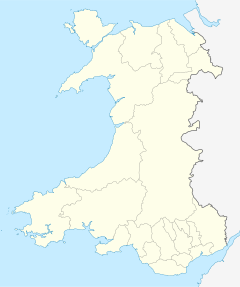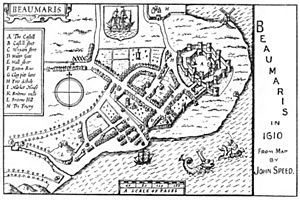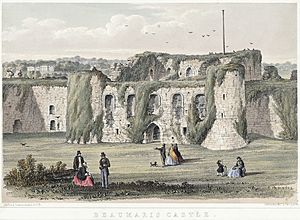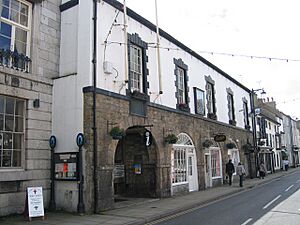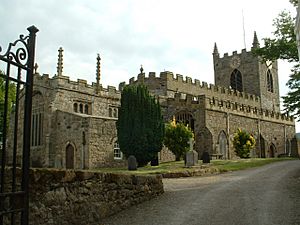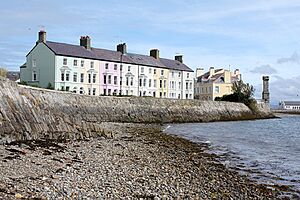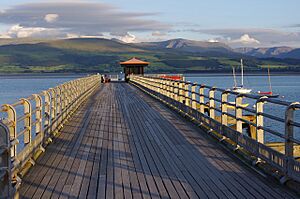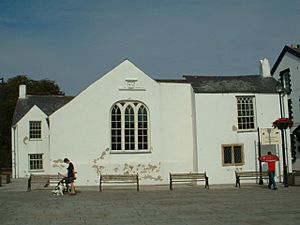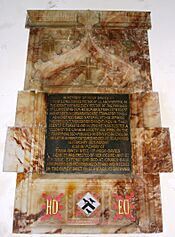Beaumaris facts for kids
Quick facts for kids Beaumaris
|
|
|---|---|
 Beaumaris Castle |
|
| Population | 1,121 (2021) |
| OS grid reference | SH6076 |
| Community |
|
| Principal area |
|
| Ceremonial county | |
| Country | Wales |
| Sovereign state | United Kingdom |
| Post town | BEAUMARIS |
| Postcode district | LL58 |
| Dialling code | 01248 |
| Ambulance | Welsh |
| EU Parliament | Wales |
| UK Parliament |
|
| Welsh Assembly |
|
Beaumaris (/boʊˈmærɪs, bjuː-/; Welsh: Biwmares Welsh pronunciation: [bɪuˈmaːrɛs]) is a town and community on the Isle of Anglesey in Wales. It used to be the main town for the county. Beaumaris is located at the eastern entrance to the Menai Strait. This is a waterway that separates Anglesey from the coast of North Wales. In 2021, about 1,121 people lived there. The nearby area of Llanfaes is also part of the community.
Contents
History of Beaumaris
Beaumaris was first a Viking settlement. It was called Porth y Wygyr, meaning "Port of the Vikings". The town as we know it started in 1295. This was when Edward I of England ordered Beaumaris Castle to be built. He had just taken control of Wales. The castle was part of a group of forts along the North Wales coast. Other castles included Conwy, Caernarfon, and Harlech.
The castle was built on a marshy area. This is how it got its name. The Norman-French builders called it beaux marais. This means "fair marsh" in English.
The old village of Llanfaes was about a mile north of Beaumaris. It was an important settlement. To keep control of the Menai Strait, King Edward I chose the flat coast for Beaumaris Castle. The castle was designed by Master James of Saint George. He was a builder from Savoy. It is known as a perfect example of a concentric castle. This means it has walls within walls. The people living in Llanfaes were moved to a new town called Rhosyr.
King Edward I gave Beaumaris a special royal charter in 1296. This charter gave certain rights to the town's English and Norman-French residents. It helped the town grow with people loyal to the king.
From 1562 until 1832, Beaumaris was a "rotten borough". This meant that a small group of people, the Bulkeley family, controlled who became the Member of Parliament.
Beaumaris was once a very busy port. All ships in North West Wales were registered here. This included ships from every harbour on Anglesey. It also covered ports from Conwy to Pwllheli. Shipbuilding was a big industry in Beaumaris. This happened at Gallows Point, a piece of land near the town. Gallows Point was also where the town's gallows were located. There was a "Dead House" for the bodies of criminals. Later, hangings took place at the town jail.
In November 1762, a ship called the Everton got stuck near Beaumaris. The passengers were saved and brought to the town. One passenger, Devereux Jarratt, wrote about how wonderful the food and the town were. He said the people looked "fresh and ruddy". He also admired the "grand and majestic" view of Penmanmawr mountain.
In 1832, a poetry festival called the "Provincial Eisteddfod" was held in Beaumaris. Young Princess Victoria and her mother attended this event.
Beaumaris has never had its own railway station. The closest one was in Pentraeth, about six miles away. That station closed in 1930.
How Beaumaris is Governed
Beaumaris has two levels of local government. There is the Beaumaris Town Council. This council is based at Beaumaris Town Hall. Then there is the Isle of Anglesey County Council, which covers the whole island.
Beaumaris was an old borough, which is a type of town with special rights. It got its first charter in 1296. In 1836, it became a municipal borough. This meant its local government worked like many other towns in Wales and England. The borough system ended in 1974. Beaumaris then became a "community". The county council now handles most of the bigger local government tasks.
Buildings and Architecture
Beaumaris has many interesting old buildings. These include the famous castle and a courthouse built in 1614. There is also the 14th-century St Mary's and St Nicholas's Church. The Beaumaris Gaol (jail) is another notable building. The 14th-century Tudor Rose is one of Britain's oldest original timber-framed buildings. The Bulls Head Inn, built in 1472, was a headquarters during the second English Civil War in 1648.
David Hughes, who was from Anglesey, started Beaumaris Grammar School in 1603. In 1952, it became a non-selective school. This happened when Anglesey County Council was the first in Britain to use comprehensive secondary education. The school later moved to Menai Bridge. Only the old hall of the original school building remains today. Beaumaris Town Hall was finished in 1785.
Beaumaris Pier opened in 1846. It was designed by Frederick Foster. The pier was rebuilt and made longer after a storm in 1872. A large building with a cafe was added at the end. It was once a place where steamships picked up and dropped off passengers. These ships included the Snowdon and La Marguerite. Larger ships had to use Menai Bridge pier instead. In the 1960s, the pier became unsafe. It was almost torn down. But a local yachtswoman, Miss Mary Burton, gave a lot of money to save it. The pier was rebuilt again between 2010 and 2012.
The Saunders Roe company built a factory at Fryars. This was because they worried their main factory might be bombed during World War II. The Beaumaris factory changed American-built PBY Catalina flying boats. After the war, the company built fast patrol boats and minesweepers there. They also made buses for London and Cuba.
Lifeboat Station
The first recorded rescue of people at sea near Beaumaris was in 1830. About 375 people were saved from a ship that had run aground. A lifeboat station was set up in 1891. It closed four years later when a nearby station got a stronger lifeboat. The Beaumaris station reopened in 1914. It is run by the RNLI.
Education in Beaumaris
Beaumaris has one primary school for younger students. Its old grammar school, which was over 300 years old, moved to Menai Bridge in 1963. It became a comprehensive school called Ysgol David Hughes.
Population and Languages
According to the 2021 UK Census, 36.8% of people aged 3 and older in Beaumaris can speak Welsh. More than half, 56.3%, said they could speak, read, write, or understand Welsh.
The 2011 census showed that 39.5% of people aged 3 and older could speak Welsh. In 2001, this number was 39.7%.
Events in Beaumaris
The Beaumaris Food Festival is held every year. It started in 2013. This festival takes place in the town and around the castle grounds.
Famous People from Beaumaris
- Sir Richard Bulkeley (1533–1621), a politician and courtier for Queen Elizabeth I.
- Catherine Davies (1773 – after 1841), a governess and writer.
- Hugh Davies (1739–1821), a botanist and clergyman.
- Charles Allen Duval (1810–1872), a painter, photographer, and writer.
- Wayne Hennessey (born 1987), a Welsh international footballer.
- Hendrik Lek (1903–1985), a painter and antique dealer.
- Richard Llwyd (1752–1835), an author, poet, and family historian.
- Reginald Wynn Owen (1876–1950), an architect.
- Neil Sloane (born 1939), a mathematician known for collecting number sequences.
Places Named After Beaumaris
- Beaumaris, a suburb of Melbourne, Victoria, Australia.
- Beaumaris, a small seaside town in Tasmania, Australia.
- Beaumaris, a neighborhood in Edmonton, Alberta, Canada.
- The village of Beaumaris in Muskoka, Ontario, Canada.
See also
 In Spanish: Beaumaris para niños
In Spanish: Beaumaris para niños


